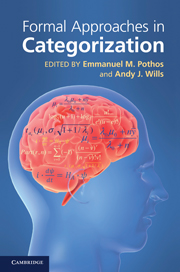Book contents
- Frontmatter
- Contents
- List of figures
- List of tables
- List of contributors
- 1 Introduction
- 2 The generalized context model: an exemplar model of classification
- 3 Prototype models of categorization: basic formulation, predictions, and limitations
- 4 COVIS
- 5 Semantics without categorization
- 6 Models of attentional learning
- 7 An elemental model of associative learning and memory
- 8 Nonparametric Bayesian models of categorization
- 9 The simplicity model of unsupervised categorization
- 10 Adaptive clustering models of categorization
- 11 Cobweb Models of Categorization and Probabilistic Concept Formation
- 12 The knowledge and resonance (KRES) model of category learning
- 13 The contribution (and drawbacks) of models to the study of concepts
- 14 Formal models of categorization: insights from cognitive neuroscience
- 15 Comments on models and categorization theories: the razor's edge
- Index
- References
2 - The generalized context model: an exemplar model of classification
Published online by Cambridge University Press: 05 June 2012
- Frontmatter
- Contents
- List of figures
- List of tables
- List of contributors
- 1 Introduction
- 2 The generalized context model: an exemplar model of classification
- 3 Prototype models of categorization: basic formulation, predictions, and limitations
- 4 COVIS
- 5 Semantics without categorization
- 6 Models of attentional learning
- 7 An elemental model of associative learning and memory
- 8 Nonparametric Bayesian models of categorization
- 9 The simplicity model of unsupervised categorization
- 10 Adaptive clustering models of categorization
- 11 Cobweb Models of Categorization and Probabilistic Concept Formation
- 12 The knowledge and resonance (KRES) model of category learning
- 13 The contribution (and drawbacks) of models to the study of concepts
- 14 Formal models of categorization: insights from cognitive neuroscience
- 15 Comments on models and categorization theories: the razor's edge
- Index
- References
Summary
Model description
Conceptual overview
According to the generalized context model (GCM) (Nosofsky, 1986), people represent categories by storing individual exemplars (or examples) in memory, and classify objects based on their similarity to these stored exemplars. For example, the model assumes that people represent the category of ‘birds’ by storing in memory the vast collection of different sparrows, robins, eagles, ostriches (and so forth) that they have experienced. If an object is sufficiently similar to some of these bird exemplars, then the person would tend to classify the object as a ‘bird’. This exemplar view of categorization contrasts dramatically with major alternative approaches that assume that people form abstract summary representations of categories, such as rules or idealized prototypes.
The standard version of the GCM adopts a multidimensional scaling (MDS) approach to modelling similarity relations among exemplars (Shepard, 1958, 1987). In this approach, exemplars are represented as points in a multidimensional psychological space. Similarity between exemplars is a decreasing function of their distance in the space. In many applications, a first step in the modelling is to conduct similarity-scaling studies to derive MDS solutions for the exemplars and to discover their locations in the multidimensional similarity space (Nosofsky, 1992b).
A crucial assumption in the modelling, however, is that similarity is not an invariant relation, but a highly context-dependent one. To take an example from Medin and Schaffer (1978), humans and mannequins may be judged as highly similar in a context that emphasizes structural appearance, but would be judged as highly dissimilar in a context that emphasizes vitality.
Information
- Type
- Chapter
- Information
- Formal Approaches in Categorization , pp. 18 - 39Publisher: Cambridge University PressPrint publication year: 2011
References
Accessibility standard: Unknown
Why this information is here
This section outlines the accessibility features of this content - including support for screen readers, full keyboard navigation and high-contrast display options. This may not be relevant for you.Accessibility Information
- 85
- Cited by
